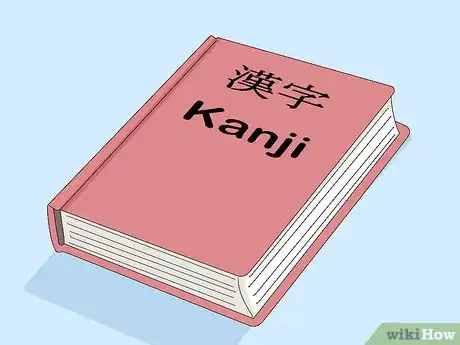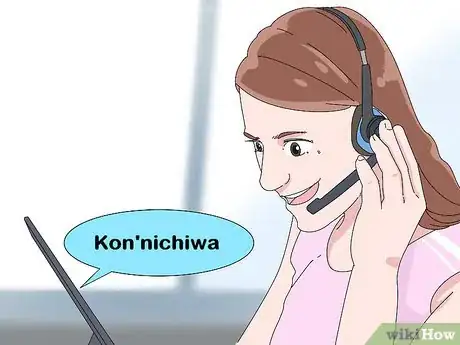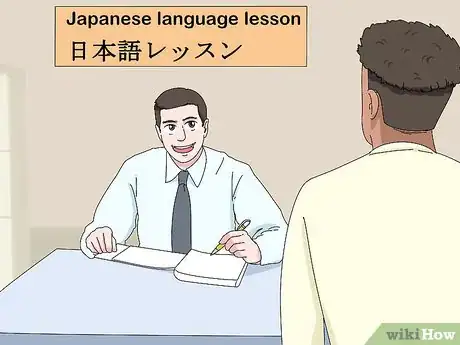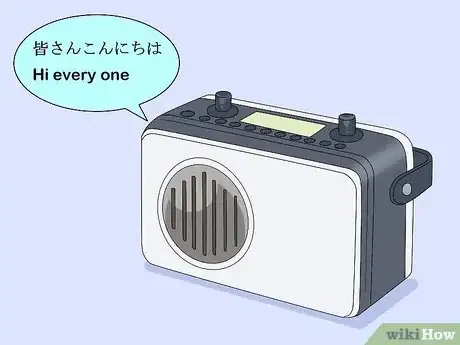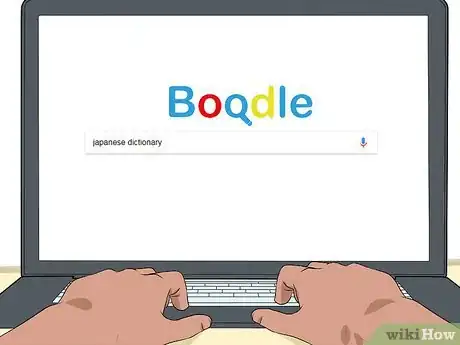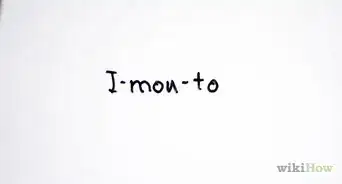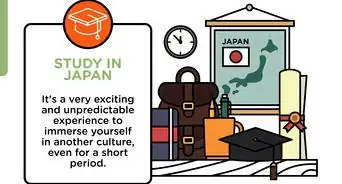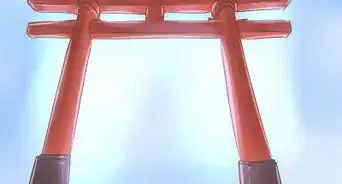This article was co-authored by wikiHow Staff. Our trained team of editors and researchers validate articles for accuracy and comprehensiveness. wikiHow's Content Management Team carefully monitors the work from our editorial staff to ensure that each article is backed by trusted research and meets our high quality standards.
There are 13 references cited in this article, which can be found at the bottom of the page.
wikiHow marks an article as reader-approved once it receives enough positive feedback. In this case, 93% of readers who voted found the article helpful, earning it our reader-approved status.
This article has been viewed 150,886 times.
Learn more...
Japanese is an East Asian language, spoken by approximately 125 million people across the world. It is the national language of Japan, but it is spoken in Korea, the United States, and many other places as well. If you are a native English speaker, Japanese will be very different. It will require practice, but with a little effort, you can become an effective Japanese speaker.
Steps
Learning the Basics
-
1Learn Hiragana. Hiragana is the Japanese alphabet. It is comprised of 51 phonetic characters, and each character stands for exactly one sound. (This is different from English in which one letter may sound different in different contexts). Once you know Hiragana, you will know how to pronounce any word in Japanese. Begin your Japanese journey by studying and memorizing these characters.[1]
-
2Learn some Katakana. Katakana is a series of characters used to stand for loan words or non-Japanese words (such as hot dog or internet). You will want to learn the Katakana terms for English words you are likely to use.[2]Advertisement
-
3Learn Kanji. Kanji are typographic Chinese symbols that are used to stand for basic words and phrases in Japanese. Whereas Hiragana symbols are more like English letters (depicting simple sounds), Kanji symbols are used to depict complete words. Knowing some basic Kanji will enable you to understand and speak basic Japanese.[3]
-
4Avoid relying on Romaji. Romaji is a system of using English letters to spell Japanese words. Romaji can be useful for learning initial key phrases, or for online communications. If you rely too much on Romaji, however, you will never move on to a genuine grasp of the language. Focus your study on Hiragana, Katakana, and some Kanji.[4]
-
5Practice grammar. In order to learn Japanese grammar, you’ll need to try to forget everything you already know about grammar. Don’t apply the rules and concepts of your native language to Japanese. Instead, try to take the rules of Japanese grammar at face value.[5]
- Obtain a Japanese grammar workbook and begin following the lessons. Some good choices include "Practice Makes Perfect: Basic Japanese" and "A Guide to Japanese Grammar" by Tae Kim.
- Locate free online resources (such as Duolingo) to study Japanese grammar.
-
6Learn some key phrases. Learning a few key phrases will allow you to begin practicing, and may allow you to enjoy some casual conversation with a Japanese speaker. Although Romaji should not be relied upon, using Romaji to learn these basic phrases can work as a good jumping off point.[6]
- Hello - Kon'nichiwa
- Goodbye - Sayonara
- I'm fine, thanks - Watashiwa genki desu. Arigato.
- Thank you very much - Domo arigato gozaimasu
- Nice to meet you - Hajime mash'te
Practicing the Language
-
1Use flashcards. You can purchase Japanese language flashcards, or make them yourself at home. You can then practice with them in a variety of ways. Flashcard can be a great way to strengthen your vocabulary in all three language systems (Hiragana, Kanji, or Katakana).[7]
- Post the flashcards around your house to label items with their Japanese names.
- You can have a friend quiz you with flashcards to practice your memorization of Hiragana letters, Kanji words, or words in Katakana.
- You can use the flashcards to quiz yourself.
-
2Speak like a kid. Small children are fantastic at learning new languages because they are not afraid to mimic sounds. They are not embarrassed. Tap into that childlike shamelessness, and practice repeating Japanese sounds, words, and phrases, even if you you’re not pronouncing them quite right.
-
3Practice with someone in person. The very best way to strengthen what you have learned and fine-tune your grammar is to practice your Japanese with another person. If you have a friend that is a native speaker, make a date and chat with them![8]
- If you don’t know any native speakers, you can search for international meet-ups or language exchange groups in your area.
-
4Talk to someone online. Another great option is to video-chat with a native speaker. There are numerous online resources that pair language partners together. Seek out a new friend who speaks Japanese and speak to them using your computer.[9]
-
5Make mistakes! Making mistakes and getting corrected by native speakers is probably the most effective way to learn the nuances of Japanese. Don’t avoid words that you are aren’t sure about or skip over phrases that you may mispronounce. Making mistakes means that you are genuinely trying to learn.
- Move outside your comfort zone.
- Get feedback from others.
- Some Japanese speakers may not want to correct you out of respect, so make it clear that you’d appreciate some guidance.
-
6Enroll in a class. One of the most effective ways to learn a new language is enroll in a class. With the guidance of an instructor, lesson plans, workbooks, and best of all, lots of other people to practice with, enrolling in a Japanese language class can be an excellent use of your time. In addition to helping you learn the language, a class like this can help you meet new people.
Encountering the Language in New Ways
-
1Watch Japanese movies. In order to learn Japanese, you’ll want to expose yourself to as much of the language as you can. Spend your down time watching films or television shows in Japanese. This will expose you to a wider range of terms (including slang) and provide you with another avenue to sharpen your understanding skills.[10]
-
2Read. Try to get your hands on Japanese books or a Japanese newspaper. This will expose you to a whole host of new words and phrases, and reading is a very active way to learn. By trying to read in Japanese you will engage deeply with this new language.[11]
-
3Listen to Japanese radio. Like television and films, listening to Japanese radio can be a great resource for encountering new words and practice listening. Seek out Japanese music with lyrics and try to sing along. Or look for Japanese talk radio.[12]
- Japanese podcasts or language learning podcasts can be great resources as well.
-
4Immerse yourself. Placing yourself in a completely immersive environment is the most effective way to learn a foreign language. If you have the opportunity to go to Japan, or even to spend time with a Japanese family in America, take it. If you have any Japanese friends, see if it is possible for you to spend a bit of time at their home.[13]
-
5Watch people talk. Speaking Japanese will require you use your mouth in a different way than you are used to. In order to produce the proper sounds, you may need to make new shapes with your lips and tongue. Watch the mouth of a Japanese-speaker to get a visual understanding of how to produce these sounds in your mouth.[14]
-
6Use electronic dictionaries. Trying to find Kanji words in a paper dictionary can be tedious. Instead, use electronic dictionaries to expand your vocabulary, fill in gaps in conversation, and aid in your understanding of new terms. You may use a free online dictionary, download an app for your phone, or invest in a pocket translator.[15]
Community Q&A
-
QuestionHow much time will it take to learn Japanese?
 DoggoTop AnswererEveryone learns at a different pace. For some people it can take 1-2 years to be fluent.
DoggoTop AnswererEveryone learns at a different pace. For some people it can take 1-2 years to be fluent. -
QuestionCan I learn basic Japanese in a month?
 Community AnswerIn about a month, you can maybe learn one of three writing systems (if you practice it every single day), have a basic understanding of some simple grammar, memorize a few words and phrases, and gain some low-level listening skills. So yes, but only if you practice every day.
Community AnswerIn about a month, you can maybe learn one of three writing systems (if you practice it every single day), have a basic understanding of some simple grammar, memorize a few words and phrases, and gain some low-level listening skills. So yes, but only if you practice every day. -
QuestionWhat sound does ' make in Japanese?
 Some UserCommunity AnswerThe ' symbol marks the break between two distinct mora (the Japanese equivalent of syllables, which consist of a single kana) and is used to differentiate between ん (n) and n combined with vowels. This is best explained with some examples: おんな is romanized as on'na because it is composed of o + n + na, while おっな would be onna because it is made of o + pause (doubles the following consonant in romanization and pronunciation) + na.This also applies to Yōon combinations like にょ nyo (ni + small yo) - こにょ is romanized as konyo (ko + ni + small yo -> aka nyo) while こんよ is kon'yo (ko + n + yo).
Some UserCommunity AnswerThe ' symbol marks the break between two distinct mora (the Japanese equivalent of syllables, which consist of a single kana) and is used to differentiate between ん (n) and n combined with vowels. This is best explained with some examples: おんな is romanized as on'na because it is composed of o + n + na, while おっな would be onna because it is made of o + pause (doubles the following consonant in romanization and pronunciation) + na.This also applies to Yōon combinations like にょ nyo (ni + small yo) - こにょ is romanized as konyo (ko + ni + small yo -> aka nyo) while こんよ is kon'yo (ko + n + yo).
Warnings
- The textbooks can get expensive and pricey, so watch out for sales.⧼thumbs_response⧽
References
- ↑ http://www.guidetojapanese.org/learn/
- ↑ http://drmoku.com/about-katakana/
- ↑ http://www.fluentin3months.com/2k-kanji/
- ↑ https://www.youtube.com/watch?v=EvtQWsJtp-M&ab_channel=TaeKim
- ↑ http://www.fluentu.com/japanese/blog/how-to-learn-japanese-grammar/
- ↑ http://www.easyjapanese.org/phrases.html
- ↑ http://www.lindsaydoeslanguages.com/6-ways-to-use-flashcards-for-language-learning-giveaway/
- ↑ http://www.guidetojapanese.org/learn/
- ↑ http://www.language-exchanges.org/
- ↑ http://matadornetwork.com/abroad/10-essential-tips-for-learning-japanese/
- ↑ http://www.roadwarriorvoices.com/2015/05/30/learn-a-new-language/
- ↑ http://matadornetwork.com/abroad/10-essential-tips-for-learning-japanese/
- ↑ http://www.omniglot.com/language/articles/languageimmersion.htm
- ↑ https://www.babbel.com/en/magazine/10-tips-from-an-expert
- ↑ http://www.guidetojapanese.org/learn/resources/findingkanji
About This Article
To start learning Japanese, try watching Japanese videos or listening to radio programs online. Additionally, get to know easy phrases like "Kon'nichiwa," which means "Hello," and "Sayonara," which means "Goodbye." You can also purchase or make your own Japanese flashcards with key words and phrases on them. Then, post them around your home so you see them every day. Once you know some phrases, try video chatting with a native Japanese speaker online through a language pairing website. For tips on how to practice Japanese grammar, read on!


